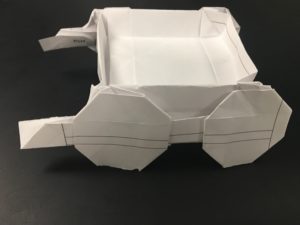Some fan art for the Campaign Podcast. This time it’s Lyntel’luroon.
Lyntel is a Twi’lek with rare short lekku. In the canon art, she’s wearing a leather helm with goggles so I decided to include those as well. Enjoy!
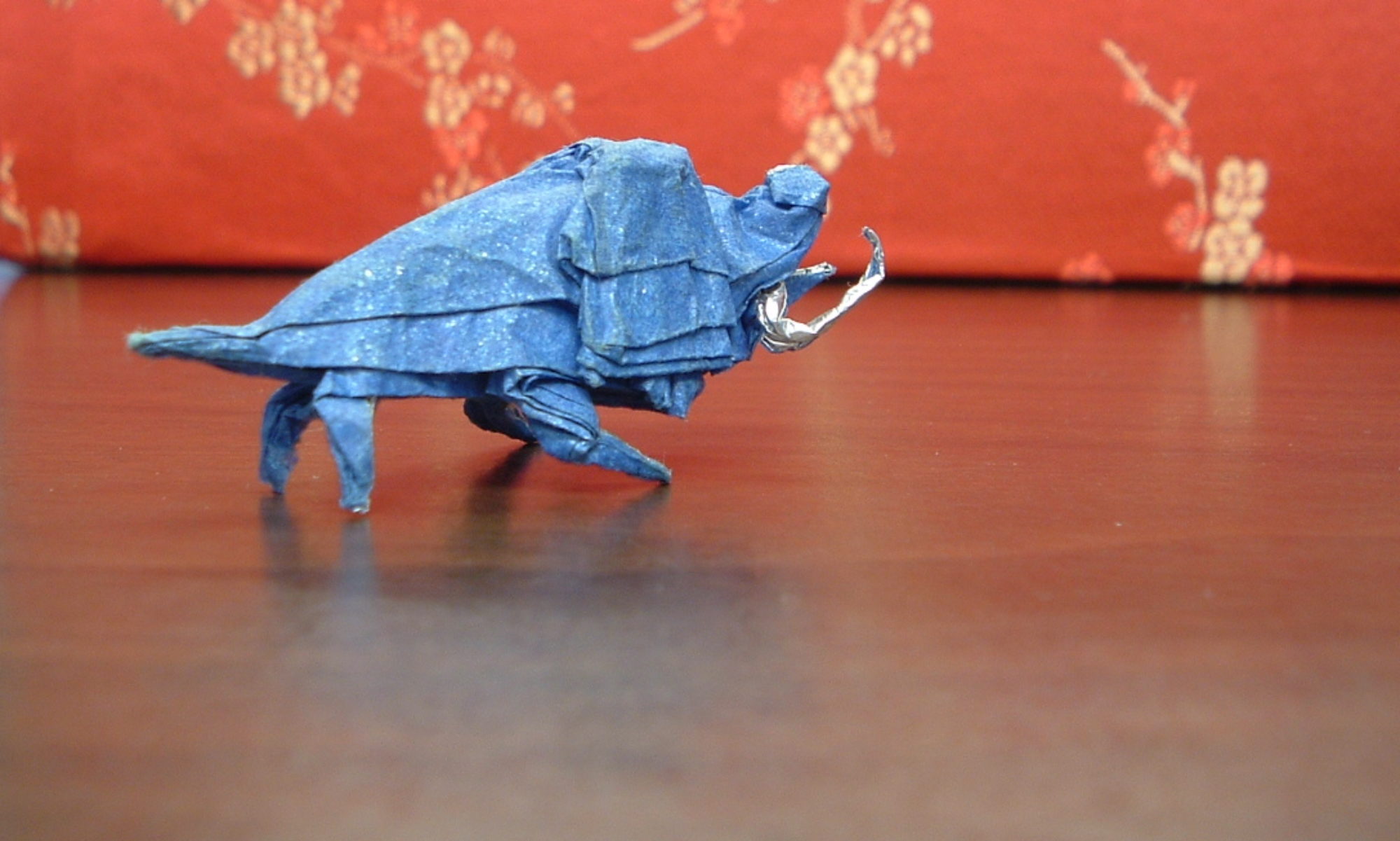
Original Origami Designs, Tabletop RPGs, and Everything In Between
Some fan art for the Campaign Podcast. This time it’s Lyntel’luroon.
Lyntel is a Twi’lek with rare short lekku. In the canon art, she’s wearing a leather helm with goggles so I decided to include those as well. Enjoy!
Tony Vornskyr is another wonderful creation from the Campaign podcast. Vornskyr are wolf-like creatures that have long tails with a poison stinger. Here’s my origami tribute:
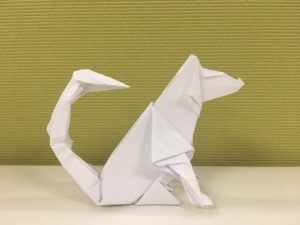
And the diagrams:
A conversation on Twitter got me thinking about a game where you go back and try to fix the things you did on your last day on earth. The premise being that you have died, and you are given a chance to fix things, but you only have so much effort you can put into it, and the end result may not be what you intended.
Thus was born Mulligan’s Dead.
It’s still in the bare bones idea phase, but here’s what I’ve got so far:
It’s a two player game. Together you and a friend will describe the last day of poor Mulligan, recently deceased. Discuss the questions below.
Once you’ve established what happened the first time around, you begin the process of going back to try your luck at fixing things.
You’ll get seven (?) scenes to try and make things better.
The clerk at the afterlife makes sure to tell you that you’ve only got so much you can do. That’s represented by your pool of dice. You get ten six-sided dice to spend.
Together, pick the first scene you’d like to do over. One of you will play Mulligan and the other will play anyone else in the scene. Together, describe the scene and get right to the meat of the action. Describe or act out what you do or say to try fixing what went wrong. When you get to a point where you feel like you’ve established the resolution you’re attempting, you’ll make a roll to see how it turns out. Keep in mind that you can’t change your own fate. Them’s the breaks, kid.
Choose any number of dice from your pool, keeping in mind that you only get ten total for the whole day.
To determine the result, roll the amount of dice you are choosing to spend and take the highest number that came up. If you choose to spend no dice, instead roll two dice and take the lowest result.
After each scene, switch roles. When you get to the end of the day, answer the following questions.
Reading No Thank You Evil made me feel like a kid again, and for good reason. It’s a tabletop RPG designed specifically to be kid friendly. It immediately put me in mind of using origami models as avatars for the player characters. Not necessarily in the sense of using maps and miniatures, but just to have something in front of them to see and touch.
That ended up being the precursor to many of the thoughts that have led up to beginning work on Paper Talisman, which I’ll cover later.
For now, it got me thinking about how to use origami models as props at the table. Traditional origami models (crane, frog, fish, etc) could all easily become characters in a world made of paper. Think Gumbo or Kubo (which is my JAM), only everything is made of paper. I started a write-up on a setting for a one shot game.
No Thank You Evil uses a pool of resources for your stats, and there are four of them, so what better way to represent that than an inverted cootie catcher / fortune teller? (Bonus points for the Castles and Crusades sourcebook I got at the raffle at AcadeCon in November!)
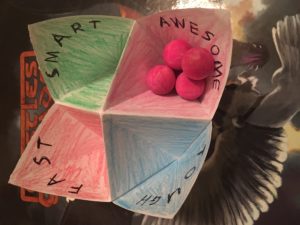
Since your players characters are traditional origami models, what sort of challenges would they face? That got the wheels turning in the usual punny directions…
But the big idea I had for the villains was that the most terrifying thing a character might face in a world made of paper would be abominations… pieced together from the cut apart bodies of their friends. Dark, yeah?
So that’s where we get to the evil Lord Scissors, and his lieutenant, a Tape Sorcerer. And they’re the only humans anyone has ever heard of. They’re creating Frankenstein’s monster-esque chimeras using tape! I’ll admit that part of me is uncomfortable with how much this reinforces stereotypes about “real” origami being one uncut square sheet, but this was a first draft.
Anyway, I commissioned the awesome Quinn Wilson to draw up the two big bads, and here they are without further ado:
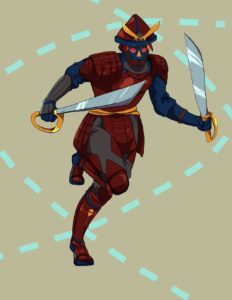
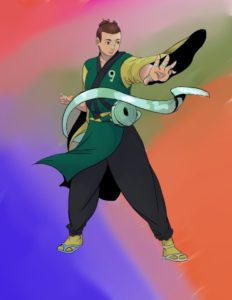
This is a collaborative storytelling game about nature and taking small steps toward making the world a better place than you found it. It’s also about looking around you to find something that speaks to you, and letting that be the starting point for a journey you take with your friends. The creative process starts as soon as you begin truly looking around you for your inspirational object. When you find it, you’ve taken your second step. When you describe it with your friends, you’ve taken the next. And so on.
It is the perfect beginning to a long hike, a camping trip, or even a relaxing day with family in your backyard. Spend some time to appreciate nature, set the tone for your outdoor experience, and have a cool adventure.
You and your friends will take on the role of druids, people with a strong connection to nature who wield its power to do awesome stuff, built from the seed of whatever object you find. Take your first steps into the natural world, and leave no trace behind.
The Setup:
Gather some six-sided dice and some friends in a place where you can find interesting natural objects. Leaves, moss, rocks, seashells, pinecones, pinches of colorful sand, discarded acorns, etc.
Give yourself five minutes to go find a natural object that speaks to you. Whatever item you choose, remember where you got it. If you can, take a picture with it. While you are looking, if you find any trash and can do so safely, pick it up while you go. You’ll use it later.
Reconvene and show everyone the object you collected, and any trash you collected. Place your object in front of you, and take any trash you collected and place it in a pile in the center of the group.
Character Creation:
Start with the player who picked up the most trash, and/or the trashiest player. They start the game by building their character. They begin by describing one aspect of the object they chose. For instance, a pinecone might be described as “Pointy” or “Hiding New Life” or “Ravaged by Squirrels”. This becomes a descriptor for their character. Your character will use them to do awesome stuff in their adventure!
Going around the circle, the next player adds a descriptor to the first player’s character, based on the object. Keep going around until you get 4 descriptors. Once the first character has been built, repeat the process for the other players until everyone has a character.
Name your newly-birthed druids. Have a sea shell? How about something like Nautilus McWavesface? Or Quelthedar of the Tides. Whatever.
Finally, go around and say out loud the name of your character and their descriptors, thusly:
“I’m Dwayne ‘The Rock’ Druidson and I am Hard, Weighty, Kinda Shiny, and have a Sedentary Lifestyle”
Play:
What dangers do your awesome druids face? Well obviously, it’s going to be rooted in your environment. Take your cues from your location and any trash you managed to pick up. If you’re at a campsite or hiking trail, take a look at the bulletin board to find information for adventure seeds. Is there an invasive species around? What about demonic creatures known as litterbugs? An industrial complex up the river? Unexploded ordnance at your local state park that used to be part of a military base? Toxic runoff from a polluted river? An alien invasion of creatures that look like remarkably like Doritos in spacesuits made of crinkly silver plastic? Whatever strikes your fancy.
Pick a single Big Danger that will be the theme of your adventure, and make sure everyone understands roughly what the party might need to do to solve it. Once everyone has a clear picture of the outline of the adventure, you can begin play.
The adventure begins with the first player setting a scene in which all the characters are presented with the first sign of the Big Danger.
To resolve the scene, players describe their character’s actions. Whenever they describe taking a non-trivial action, they get to roll some dice to see whether they were successful. The group suggests outcomes based on the roll, but the player rolling has final say. Things that average people can do are fine, but feel free to think up whatever you like. If you’re a seashell druid, use the power of water to crash a tidal wave over your enemies. If you’re a pinecone druid, summon a cyclone filled with your pointy brethren and kick some bad guy butt!
For each descriptor incorporated into the description of their action, they get one additional die to roll. They can also “use up” one of the pieces of trash from the communal trash pile to gain additional dice (1 per piece of trash used). If any of the dice are a 5 or higher, the action is successful. Rolling all 1’s or all 6’s results in something extraordinarily bad (low) or good (high) happening. The more dice you rolled, the bigger the good or bad effect.
If there’s no trash left and you can’t think of a way to link up a descriptor, roll a single die. If it’s a 6, you succeed. Otherwise, you fail.
Example of Play:
Dwayne “The Rock” Druidson’s descriptors are Hard, Weighty, Kinda Shiny, and Sedentary Lifestyle. They are in a scene where they need to beat up a little demon known as a Litterbug. They argue that their fists are Hard, and they’ve got lots of Weight to put behind the punches. They get to roll two dice. They roll a 3 and 6. They succeed! That litterbug is in for a world of hurt.
Needler of the Pines’ descriptors are Pointy, Goddamn Everywhere, Flexible, and All Dried Up. She needs to sneak past a wary dog off his leash. She describes how she wriggles through the dense underbrush (Flexible) covered in a camouflage ghillie suit of pine needles she collected from the forest floor (Goddamn Everywhere). She rolls two dice and get a 1 and 1. She fails, really badly! Sounds like someone is about to become dog chow.
Leaf Erikson’s descriptors are Flaky, Kinda Transparent, Dead But Colorful, and People Come To See Me From Miles Around. He is trying to convince the local king of the trash bandits that he’s actually a new member of the gang. He can’t think of a way to link up any of his descriptors to the task, so he decides to use three pieces of trash from the communal trash pile, since this is an important bluff. He rolls an amazing triple 6 on the dice. The bandit king totally buys it, and something super cool happens.
Awesome, now what? Work as a group to decide what scenes make sense in progressing the group toward resolving the Big Danger. If you like, you can take turns going around and setting scenes after each one is resolved, or simply crowd-source whatever makes sense.
The Resolution:
Congratulations! You’ve solved a Big Danger (or died trying). Next up is to help out in real life. Dispose of the trash in an appropriate receptacle, recycling recyclables, etc. Finally, take the natural object you used for the game and place it back where you found it. Thank it out loud for being each of its descriptors. Seriously.
“Thanks ‘The Rock’ for being Hard, Weighty, Kinda Shiny, and having a Sedentary Lifestyle”.
It will be cool. Trust me.
Now, you’ve taken your first steps into nature and leaving it better than you found it. Go forth and enjoy the rest of your time with your friends and the outdoors!
Thanks!
Thanks to Taylor Labresh and Darcy Ross for the brainstorming session that inspired this.
Made a cute little two-headed giant for Ettin News, an advice column podcast run by an ettin!
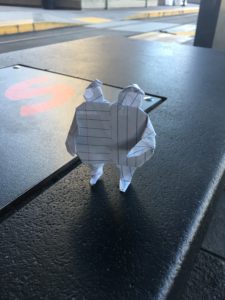
Diagrams:
Listening to the Swallows of the South podcast got me in the mood to fold a bird. The challenge with a swallow is the forked tail, but I think it turned out rather nicely.
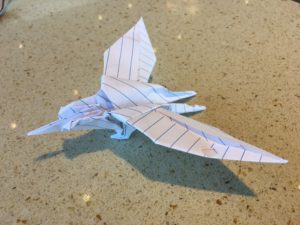
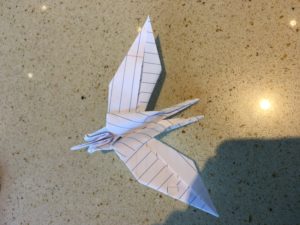
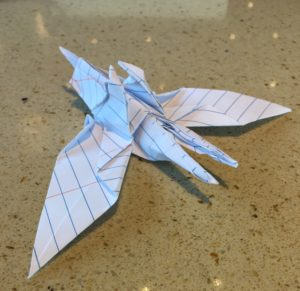
And the diagrams:
This is a little fan art for the All My Fantasy Children podcast, where they create bizarre, hilarious characters to populate your RPG settings based on listener prompts every week.
Pumpkin Jay is a sentient pumpkin… pretty spooky stuff!
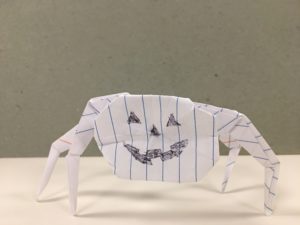
It’s a wagon! Or a cart! Or… a squarish thing with some octagonal wheels!
This was a fun little experiment to see if I could do a wagon or cart that would fit in with a horse or fantasy miniatures or some such. In the end, I think I’d probably just go with a papercraft wagon (cutting and tape and whatnot) or a plastic toy wagon, but it was an interesting challenge.
